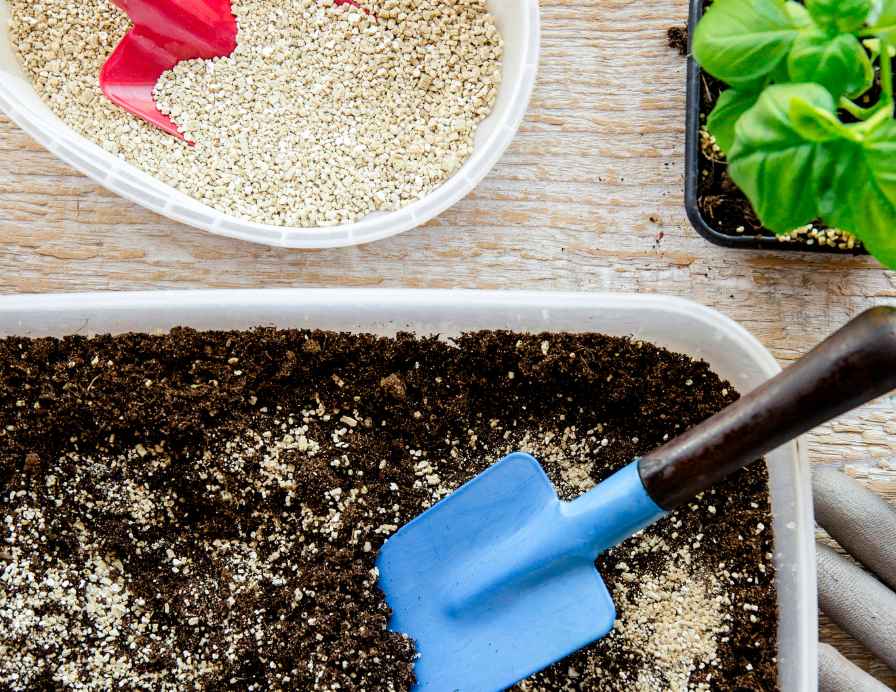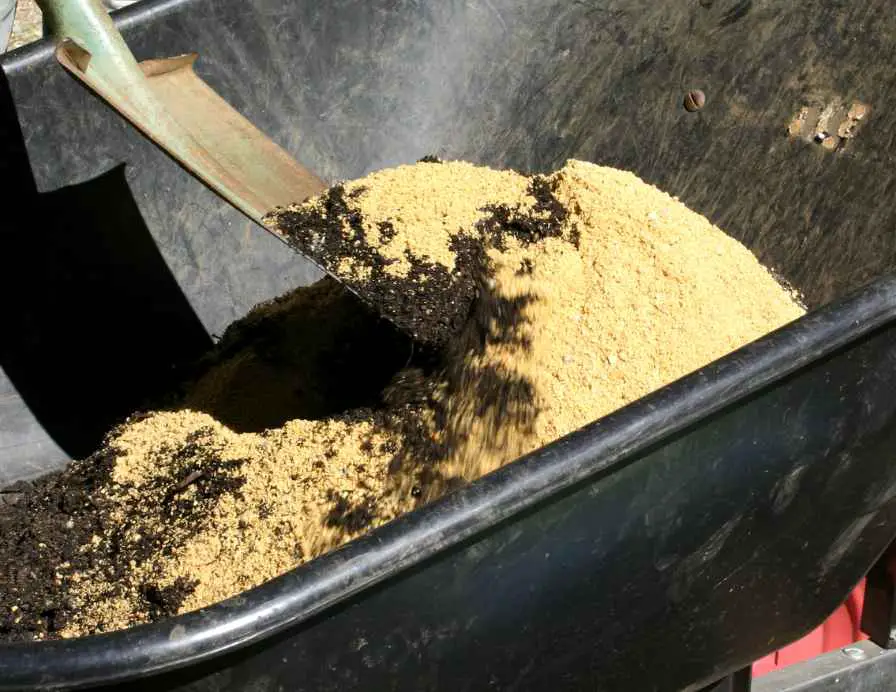There are many ingredients available in the market to make a soil mix. Also, the garden soil is also available and the potting soil is also available in garden stores. But what about the best garden soil mix DIY? How we can make it by ourselves. Well, we are going to discuss it today.

Importance of Good Garden Soil Mix
For effective gardening and plant growth, a quality garden soil mix is crucial. All plant life is supported by the soil, which offers vital nutrients, aeration, and drainage. A balanced soil mixture promotes root growth, nutrient absorption, and water retention, which fosters the best conditions for plant growth.
First of all, a healthy garden soil mixture makes sure that plants get the nutrients they need for growth and development. A healthy plant’s development depends on nutrients like nitrogen, phosphorus, and potassium, which are present in nutrient-rich soil.
Plants can withstand illnesses and environmental stressors thanks to strong root systems, sturdy stems, and brilliant leaves that are supported by adequate nutrition levels.
Second, the soil mix’s texture and composition are important considerations. Because waterlogging is avoided by well-draining soil, plant roots have access to both water and oxygen. The presence of too much moisture close to the roots can cause root rot and other fungi infections.
More Benefits Of Best Soil Mix
On the other hand, during dry spells, a soil mixture with great water retention capacity will guard against drought stress. The structure of the soil also permits optimum aeration, encouraging advantageous microbial activity, which aids in the breakdown of organic matter and the release of nutrients for plant uptake.
Finally, a well-balanced garden soil mix gives plant roots a secure and nurturing environment. Plants need strong root systems to attach themselves firmly and to maximize nutrient intake. They can obtain more nutrients and water when their roots can easily penetrate the soil and spread out.
Plants that are healthier as a result develop and produce more effectively overall and are better able to withstand environmental changes.
Common Ingredients Used in Best Soil Mix
Making a garden soil mix includes mixing several components to produce a medium that is balanced and encourages plant development. The common components included in a garden soil mixture are listed below, along with thorough descriptions of each one:
Topsoil
The top layer of soil is rich in nutrients, organic materials, and beneficial microbes. Topsoil serves as the foundation for the garden soil mixture and supplies vital nutrients and components for proper plant growth.
To ensure that plants receive a consistent supply of moisture without becoming saturated, topsoil enhances water retention and drainage. Look for dirt that is contaminated-free, black, and crumbly.
Compost
Organic material that has decomposed, such as food scraps, yard trash, and manure, is compost. It is a useful addition to the garden soil mixture since it improves the soil’s structure and nutritional content.
Compost promotes a healthy soil ecology by increasing soil aeration and aiding in moisture retention. Furthermore, it encourages advantageous microbial activity, which helps decompose organic materials and liberate nutrients for plant absorption.
Vermiculite or Perlite
These are sterile, portable materials that enhance soil drainage and aeration. Vermiculite is a mineral that expands when heated, whereas perlite is created from volcanic glass.
Both components aid in preventing soil compaction and allowing air to reach the roots, which encourages the growth of healthy roots. It aids in moisture retention without resulting in waterlogging, establishing the perfect balance for plant development.
Peat Moss
Peat moss is a sort of organic material made from sphagnum mosses that have degraded. It is a valuable part of the soil mix because of its outstanding water retention qualities and ability to keep moisture effectively, especially for plants that demand more constant moisture levels. Peat moss should be utilized with care, though, as its extraction might have a harmful effect on the ecosystem.
Sand
Sand helps the soil drain better and prevents waterlogging. By making the soil mix more open and well-structured, it makes it easier for more water to drain through. Sandy soils are good for plants that like it dry, but too much sand can cause nutrient leaching, therefore it needs to be balanced with other elements.
Flowable Loam or Clay Soil
Its ability to store water and nutrients can be increased by including a small quantity of permeable clay or loam soil. Due to their high cation exchange capacity (CEC), clay particles are able to exchange and store nutrients with plant roots. Avoid adding too much clay, though, since this might compress the soil.
Fertilizers
Even though compost contains a lot of nutrients, certain plants can still need further fertilization. To meet these requirements, you can add balanced organic or slow-release fertilizers to the mixture. In order to prevent over-fertilization, which might damage the plants, always adhere to the specified application rates.
Best Garden Soil Mix DIY

There are a few crucial procedures involved in making the best garden soil mix DIY with the items listed above. For precise directions on creating a nutrient-rich, well-balanced soil mixture for your garden, see below:
Assemble the Components
Gather all the components you’ll need to make your garden soil mixture. Sand, permeable clay or loam soil, topsoil, compost, perlite or vermiculite, peat moss, and optional organic or slow-release fertilizers are also required. Make sure the compost and topsoil are of high quality and free of impurities.
Determine the Quantities
Calculate how much garden soil mix you’ll need for your planters or garden beds. To get the area’s total volume in cubic feet or cubic meters, measure the area’s length, breadth, and depth. Estimate how much of each component you’ll need based on the volume needed.
Aim for 40–50% topsoil, 20–30% compost, 10–20% perlite or vermiculite, 10–20% peat moss, and 10–20% sand as a general guideline. Smaller additions of the permeable clay or loam soil, approximately 5–10%, are possible.
Put the Container or Garden Bed in Place
Use a big bucket or wheelbarrow to combine the materials if you’re creating a small batch for container planting. You may mix the soil right on the garden bed itself for bigger garden beds. Make sure the container or bed is tidy and debris-free.
Mix the ingredients
Topsoil should first be added to the container or plant bed. Spread it evenly and break up any clumps. Add the compost next to the mixture. Distribute compost evenly throughout the topsoil to enhance soil structure and give vital nutrients.
Include the Organic Material
Peat moss should be mixed in. Since peat moss has high water retention qualities, it’s crucial to spread it out uniformly to maintain constant soil moisture levels. Mix the dirt, compost, and peat moss thoroughly with a shovel or garden fork.
Enhance Aeration and Drainage
Vermiculite or perlite should now be added to the mixture. These components enhance soil drainage and aeration, which is essential for strong root growth. Once more, thoroughly combine the ingredients to make sure they are spread equally.
Enhance the capacity to hold water and nutrients
If you choose to use permeable clay or loam soil, scatter a sparse layer over the mixture and stir it in. Avoid adding too much clay as this may cause soil compaction. The mix’s ability to store water and nutrients may be improved by this addition.
Optional Fertilizers
If you decide to use fertilizers, make sure to apply them according to the manufacturer’s recommendations. In general, organic or slow-release fertilizers are advised since they give the plants a consistent supply of nutrients throughout time. To achieve a uniform distribution, carefully stir the fertilizers into the soil mixture.
Test and Adjust
Examine the texture and moisture level of the garden soil mixture after complete mixing. It needs to be crumbly, well-structured, and able to retain moisture without being soggy. Depending on the particular needs of your plants, adjust the mixture as necessary by adding more compost for extra nutrients or sand for better drainage.
Fill Your Garden Beds or Containers
Fill your garden beds or containers after your soil mixture is prepared. Once the plants are placed, gently firm the dirt around them. To assist the soil surrounding the roots settle, thoroughly water the newly planted area.
In a nutshell, utilizing the mentioned items, you can make the best garden soil mix DIY by following these instructions. To guarantee your plants grow and prosper in your garden, remember to frequently test the soil mixture and adjust it as necessary, depending on the performance and demands of your plants.
FAQs
What can I mix to make good garden soil?
There are many ingredients that are available to make the soil good. You can add any of it. You should check and test the oil so that you should what is the deficiency. Then you add the perlite, peat moss, topsoil, compost, or any of those items.
What is the best soil composition for a home garden soil?
You can keep the proportion of ingredients in the garden soil equal. It should be 33% coconut fiber or peat moss, 33% topsoil, or 33% compost. It will get you good draining soil.
Is manure good for the garden?
Manure is good for the garden. It helps in improving the soil structure and provides nutrients to the plants and the soil as well.

